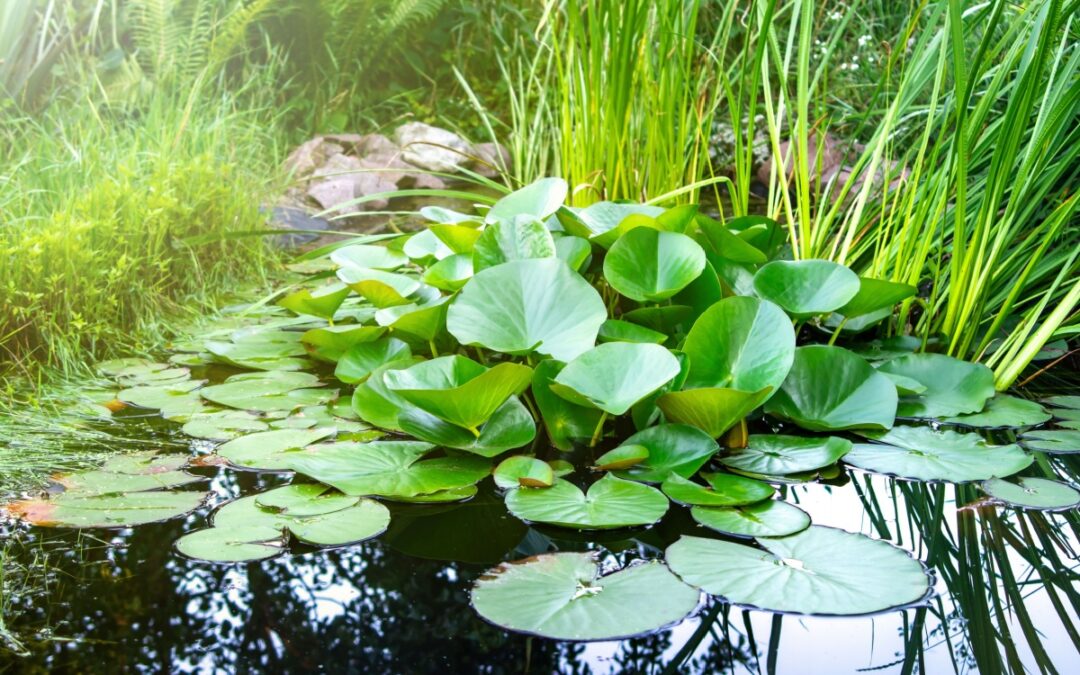Take a stroll by a local pond or lake, and you’ll likely encounter a variety of plants thriving both in and around the water. Nature has a way of populating bodies of water with a diverse range of plants. Some, like water lilies and cattails, add beauty and provide essential habitat for aquatic life. Others, however, can be invasive, choking out native species and disrupting the delicate balance of the ecosystem. Understanding how the plants around your body of water affect its health and appearance is key to maintaining a pond that will last for generations to come.
What Are Aquatic Plants?
Unlike terrestrial plants, aquatic species have adapted to survive fully or partially submerged in water. They come in various shapes and sizes, with different growth habits and functions. Here’s a quick breakdown of the three main types:
- Submerged Plants: These beauties live entirely underwater, providing oxygen and hiding spots for fish. Examples include bladderwort, hydrilla, and elodea.
- Emergent Plants: These plants root underwater but have their leaves and stems protruding above the water’s surface. Cattails, bulrushes, and pickerelweed are common examples.
- Floating Plants: As their name suggests, these plants float freely on the water’s surface. Water lilies, duckweed, and water hyacinths fall into this category.
The Top Benefits of Aquatic Planting
Does your pond look a bit boring? Is it missing vibrant colors and different textures? Or is the water too green and murky? Whether your body of water could use an aesthetic boost or requires intervention to prevent the growth of algae, adding more aquatic plants to your property could be exactly what you need to do. Creating a balanced and healthy ecosystem is one of the top benefits of aquatic planting:
Improved Water Quality
Aquatic plants act as natural filters by absorbing excess nutrients, such as nitrogen, phosphorus, and other byproducts of agricultural runoff or decaying organic matter. By reducing these nutrients, plants help prevent harmful algae blooms that could otherwise devastate the aquatic environment. The plants’ root systems also stabilize sediment to reduce turbidity and maintain clearer water.
Erosion Control
Plants with extensive root networks anchor soil in place, protecting shorelines from erosion caused by water movement or human activity. Emergent plants like bulrushes and cattails are especially effective, forming a natural barrier that guards against shoreline deterioration.
Oxygen Production
During photosynthesis, aquatic plants convert sunlight into energy, releasing oxygen into the water. This enhances dissolved oxygen levels, which is crucial for the survival and health of fish, insects, and other aquatic organisms.
Habitat Creation
Aquatic plants create essential habitats for fish, insects, and birds. Submerged plants offer protective cover for young fish, while emergent and floating-leaf plants provide nesting sites and food sources for birds and insects. A diverse range of plants ensures a thriving aquatic environment by supporting the needs of various species.
Aesthetic Appeal
The vibrant flowers and lush greenery of aquatic plants add visual beauty to any pond or lake. Whether it’s the delicate blooms of water lilies or the strong appearance of rushes and cattails, these plants create an environment that is striking to behold.
When Do Aquatic Plants Become Problematic?
While strategically chosen aquatic plants offer a wealth of benefits, uncontrolled plant growth can create problems. Some aquatic plants are aggressive growers and can quickly take over a pond, crowding out other beneficial plant life and reducing oxygen levels. It’s best to familiarize yourself with invasive species in your region and avoid introducing them to your pond.
Also, note that overstocking a pond with fish and excessive fertilization can lead to an overabundance of nutrients in the water. This can trigger excessive plant growth, tipping the balance in favor of algae blooms. Consider partnering with a professional pond management company to prevent an overabundance of aquatic plants.
Transform Your Pond Today
If you’re looking for a professional solution to optimize your pond or lake’s aquatic life, turn to Aquagenix. Our comprehensive aquatic planting service uses science-backed techniques to manage aquatic plants and algae while fostering a balanced environment. Our experts can assess your water body’s unique needs and create a customized plan that ensures long-term health and beauty.
From promoting plant growth that benefits water quality to curbing invasive species, we offer the perfect solution for your pond management needs. So, reach out to us today to learn more about how we can help you benefit from aquatic planting.


Recent Comments